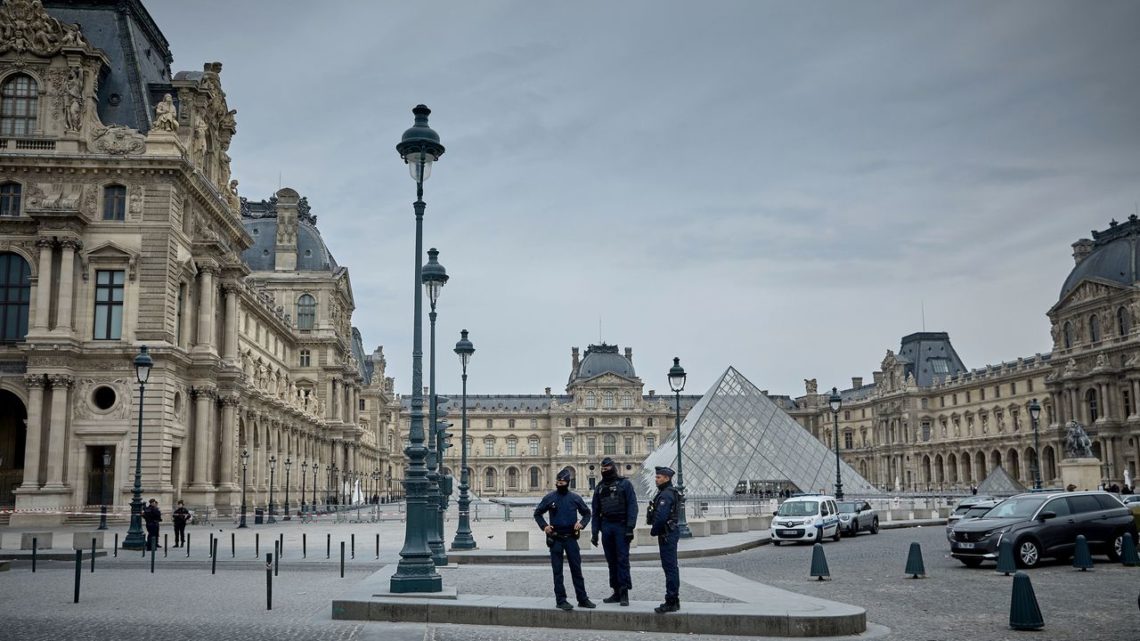Just hours after the Louvre Museum was targeted by thieves Sunday morning, news outlets were already calling it the heist of the century. But while it was immediately clear that the museum had been targeted by skilled professionals, it was also obvious that those career criminals had made a few mistakes. On their way out of the museum, the thieves dropped one of their spoils—a crown that once belonged to Empress Eugénie. On Thursday, police told local news outlet Ouest France that the thieves had also abandoned a helmet, angle grinders, gloves, and a vest, allowing law enforcement to take 150 different samples that might help them catch the crooks.
The thieves also left behind one of their most important tools. They had entered the museum’s Apollo Gallery by parking on the street outside and simply backing a truck equipped with an elevating platform and a ladder to the window. They cut a hole with a plate-glass cutter, slipped in, and escaped—not bothering to take the truck with them. As it turns out, the vehicle is manufactured by Böcker, a German company that wasted no time seizing on its newfound infamy. The company quickly shared an image of the theft on its Instagram, accompanying it with a jokey caption: “When you need to move fast,” it reads, “The Böcker Agilo transports your treasures weighing up to 400kg at 42m/min—quiet as a whisper.”
Elaine Sciolino, former Paris bureau chief of the New York Times, tells Vanity Fair that she thought the German company’s response was in “breathtakingly bad taste.” That said, she’s also fascinated by some of the robbery’s stranger details—and notes that the confusing nature of the building itself might have made it an ideal target for daring yet derelict thieves. “The problem of the Louvre is it was not built as a museum. It was built as a fortress in the Middle Ages,” she says. “It became a palace where kings restored and renovated it, and their egos were more important than engineering rationality. It makes no sense.”
Though the Louvre has become one of the most trafficked tourist destinations in the world, it still operates on an old-world logic. “It’s on 25 different levels, with different eras of construction—all different sizes and thicknesses of walls,” says Sciolino. “There are 4,000 keys, and they don’t even know if all of them work. There are doors that go nowhere.”
For her recent book, Adventures in the Louvre: How to Fall in Love with the World’s Greatest Museum, Sciolino went behind the scenes to learn about the security and fire-safety practices at the Louvre. Her research indicates that the museum could have been prepared for thieves wielding battery-powered angle grinders: “The glass display cases that contained the jewels had to be secure enough to deter thieves or tampering, but flexible,” she says. The Louvre has a permanent force of firefighters in the building 24/7, sapeurs-pompiers who serve in the French military. “They also have protocols for breaking into the glass cases and seizing any items, whether it’s a sculpture or whether it’s a crown jewel. They have to be trained on all the different tools that you have to be able to use to grab a painting or break a glass case.” On her Instagram account, Sciolino shared a photo of similar angle grinders as they appear in the Louvre firefighters’ own handbook.
Yet somehow, the thieves slipped right past them—and the greater irony is that the theft happened just before the Louvre’s facilities were due for a makeover. In a private memo that leaked in January, Louvre director Laurence des Cars mentioned a “worrying level of obsolescence” at the museum. In February, President Emmanuel Macron responded by announcing plans for a “Louvre Renaissance,” that would renovate the building and its famous IM Pei–designed glass pyramid entrance.
Sciolino notes that the recent conversation about the Louvre’s inadequacy has focused mainly on its infrastructure, rather than the sort of security measures that might have prevented Sunday’s incident. “Security has not been front and center as a potential problem in the Louvre,” she says. “More important has been overcrowding, crowd control, and infrastructure problems like leaky roofs and broken water pipes.…The whole building is leaking—you go anywhere in the Louvre on any day, and you can find leaks.”
Ultimately, Sciolino says that the Louvre’s enigmatic features are part of its charm. “It’s a museum where you have to let yourself go and just wander—let the Louvre be your guide. Otherwise, you’re going to be very frustrated by the crowds, by the noise, by the corridors that go nowhere,” she says. “As a former war correspondent, I say this all the time: you’re going into battle. Never go into the Louvre on an empty stomach and with a full bladder.”
Her understanding of the building’s history actually makes it harder for her to laugh at some of the more absurd aspects of the heist. “The Louvre was basically the center of French power, and that’s why it’s so important in the French psyche,” she says. The robbery “is a dagger into the heart of the Louvre, and into the heart of France.”
More Great Stories From Vanity Fair
-
What Bari Weiss Means for 60 Minutes
-
All About Melania
-
Meet the British ’90s It Girl Who Wants to Make England Great Again
-
Anjelica Huston’s Cultured Coolness
-
Gore Vidal’s Final Feud
-
The 6 Grisly Films Inspired by Serial Killer Ed Gein
-
Charlie Kirk, Redeemed by the Media
-
The 25 Best Movies to Watch on Netflix This October
-
From the Archive: The Hollywood Secret Katharine Hepburn Helped Bury
The post A Louvre Expert Explains That the “Egos” Who Built the Museum Also Made It Susceptible to a Heist appeared first on Vanity Fair.




